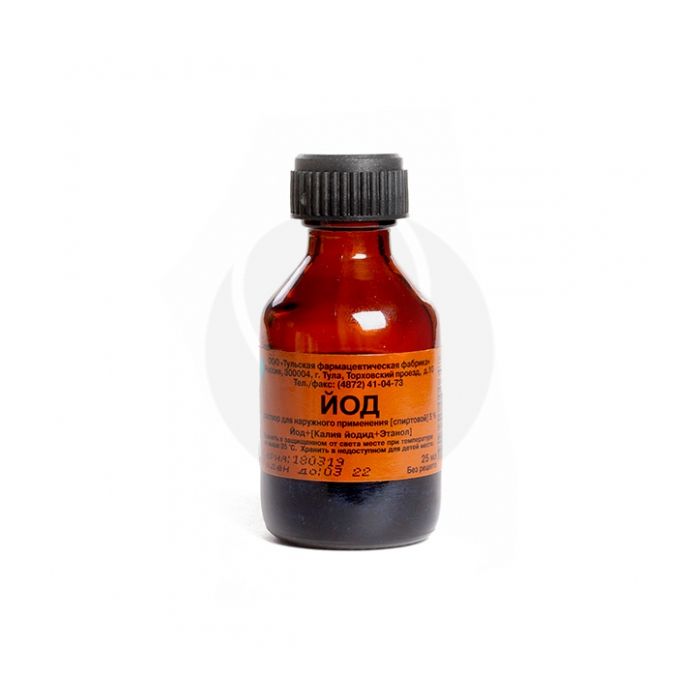Iodine alcohol solution 5%, 25ml
Expiration Date: 05/2027
Russian Pharmacy name:
Йод спиртовой раствор 5%, 25мл
For external use: infectious and inflammatory skin lesions, trauma, wounds, myalgia.
For local use: chronic tonsillitis, atrophic rhinitis, purulent otitis media, trophic and varicose ulcers, wounds, infected burns, fresh thermal and chemical burns of I-II degree.
When applied externally, iodine is used to treat damaged areas of the skin.
Locally used for washing lacunae and supratonsillar spaces - 4-5 procedures at intervals of 2-3 days, for irrigation of the nasopharynx - 2-3 times a week for 2-3 months, for instillation into the ear and rinsing - for 2-4 weeks; in surgical practice and in case of burns, gauze napkins applied to the affected surface are moistened as needed.
Solution for external use alcohol 5% transparent, red-brown color, with a characteristic odor.
100 ml
iodine 5 g
Hypersensitivity to iodine
pharmachologic effect
Elemental iodine has pronounced antimicrobial properties. Elemental iodine preparations are characterized by a pronounced local irritating effect on tissues, and in high concentrations - a cauterizing effect. Local action is due to the ability of elemental iodine to precipitate tissue proteins. Preparations that split off elemental iodine have a much less pronounced irritant effect, and iodides have local irritating properties only in very high concentrations. The nature of the resorptive action of elemental iodine and iodide preparations is the same. The most pronounced effect of the resorptive action of iodine preparations is on the function of the thyroid gland. With iodine deficiency, iodides contribute to the restoration of impaired synthesis of thyroid hormones.With a normal iodine content in the environment, iodides inhibit the synthesis of thyroid hormones, the sensitivity of the thyroid gland to the TSH of the pituitary gland decreases and its secretion by the pituitary gland is blocked. The effect of iodine preparations on metabolism is manifested by the intensification of dissimilation processes. In atherosclerosis, they cause a slight decrease in the concentration of cholesterol and beta-lipoproteins in the blood; in addition, they increase the fibrinolytic and lipoproteinase activity of blood serum and slow down the rate of blood coagulation. Accumulating in syphilitic gums, iodine promotes their softening and resorption. However, the accumulation of iodine in tuberculous foci leads to an increase in the inflammatory process in them. The release of iodine by the excretory glands is accompanied by irritation of the glandular tissue and increased secretion.This is due to the expectorant effect and stimulation of lactation (in small doses). However, in large doses, iodine preparations can inhibit lactation.
Pharmacokinetics
Upon contact with the skin or mucous membranes, 30% turns into iodides, and the rest into active iodine. Partially absorbed. The absorbed part penetrates into tissues and organs, is selectively absorbed by the thyroid gland. It is excreted mainly by the kidneys, intestines, sweat and mammary glands.
Side effect
When applied externally: rarely - skin irritation; with prolonged use on extensive wound surfaces - iodism (rhinitis, urticaria, Quincke's edema, salivation, lacrimation, acne).
Application during pregnancy and lactation
Contraindicated for oral administration during pregnancy.
Application for impaired renal function
With nephritis and nephrosis, it is contraindicated for oral administration.
Application in children
Contraindicated for oral administration in children under 5 years of age.
special instructions
With prolonged use, the phenomena of iodism are possible.
Drug interactions
Pharmaceutically incompatible with essential oils, ammonia solutions, white sedimentary mercury (an explosive mixture is formed). An alkaline or acidic environment, the presence of fat, pus, blood weaken the antiseptic activity. Weakens the hypothyroid and strumogenic effect of lithium preparations.

